Hyperrhiz 12
Situating Change: Combinatory Writing, Collaboration, and Technopolitical Reality
Scott Rettberg
University of Bergen
Citation: Rettberg, Scott. “Situating Change: Combinatory Writing, Collaboration, and Technopolitical Reality.” Hyperrhiz: New Media Cultures, no. 12, 2015. doi:10.20415/hyp/012.me01
Abstract: Beyond the novelty of engaging with new technologies, multimedia platforms, and computational methods that can stretch writing in new ways, introduce new modes of literary signification, new forms of internationally networked creative community, and new amalgamations of literature and other art forms, this essay argues that electronic literature is particularly well-suited to mapping culture during a period of ubiquitous technological transformation.
The theme of this issue of Hyperrhiz is "mapping culture." This is apropos of the subject I address here , "situating change." Beyond the novelty of engaging with new technologies, multimedia platforms, and computational methods that can stretch writing in new ways, introduce new modes of literary signification, new forms of internationally networked creative community, and new amalgamations of literature and other art forms, I argue that electronic literature is particularly well-suited to mapping culture during a period of ubiquitous technological transformation. The global network, mobile technologies, and many other technological innovations have clearly already changed contemporary culture in ways that affect nearly every aspect of our lives in positive and negative ways. Our communication technologies and to some extent the very nature of our social relations have changed profoundly during the past several decades. Simultaneous with an accelerated pace of technological change, we are forced to come to grips with the increasingly evident consequences of the anthropocene obsession with technological progress: for example the effects of global warming, toxic environments, and mass extinction.
Paul Virilio's warnings that the ever-increasing power of the military-industrial complex would only be accelerated by advancement of network technologies, that the Internet might ultimately be best understood as a surveillance weapon and war machine — an "Information Bomb" — have largely already been realized, as Edward Snowden's 2013 revelation of the NSA's wholesale surveillance program reiterated. Even as Silicon Valley billionaires spin venture capital into apps and IPOs, Bitcoin and gold, drones target enemies on an approved kill-list in a seemingly perpetual campaign of assassination-based warfare. We have incredible access to knowledge, information, entertainment, and consumer electronics that would have seemed like science-fiction during my childhood but also the unenviable responsibility of explaining to our own children such phenomena as frequent terrorist attacks, nuclear meltdowns, robot assassins, government-sanctioned torture, school shootings, YouTube beheadings, and mass crucifixions.
Time has passed and advancements have been made, but they cannot all be understood as progress. The contemporary network is neither an anarchy nor a democracy. Capital has won. We inhabit social networks online. The Internet is dominated by flows of capital, by the generation and consumption of discourse, "user generated content" which is subsequently harvested, utilized, manipulated and controlled by corporate actors and other centers of power. The literal flows of energy involved in the Internet are also non-trivial. Many estimates now put the portion of the world's energy consumption used by internet applications and infrastructure at around 10% . Every iPhone annually consumes about the same amount of energy as an efficient refrigerator.
I remember my first encounters with the fascinations of the network. I remember the wonder of it, the sense of sudden expanded access to a borderless world. When the first World Wide Web browser, NCSA Mosaic, came out in 1993, I was taking a graduate class in Visible Rhetoric at Illinois State University. Our professor, Jim Kalmbach, cancelled most of whatever we had scheduled for that day to show us the browser that the National Supercomputing Agency at the University of Illinois had just released to the general public. We had been using email clients and FTP on Gopher for years, but this seemed like a game-changer. Using a simple easy-to-learn markup language, people all over the world were not only able to share files, texts, images, sounds, and even video, but to bring all of these media elements together in one universally accessible multimedia environment. We could see, and shape, and design in this new public space. By simply publishing materials on a server, we could make them instantaneously available to anyone in the world with an internet connection. We could each stake a claim here, set up a "home page" and be part of a publishing revolution. Every writer could be a publisher, every digital artist could have a gallery. Weblogs followed home pages, and journals and special interest sites of all kinds sprang up to address every concern.
The mind reeled at the possibilities. We could conceptualize new art forms, we could imagine new kinds of social and political engagement, we could dream up consensual communities that transcended borders and governments. Walls had fallen everywhere, and for a moment it seemed as if the World Wide Web represented a technological manifestation of possibility, a potentially world-changing thing.
In retrospect, perhaps we now remember this spirit of techno-utopianism in the same way that the radicals of the 1960s remember the protest movements of their youth, long before they got corporate jobs, mortgages, and sports utility vehicles. The network has primarily become a network of capital flows dominated by a relatively small group of corporate actors, information-and-attention brokers who supply us with great bread-and-circus. And we get a lot from the network: an inexhaustible ocean of data, the greatest library the world has ever known, nearly-simultaneous one-click delivery of goods and services, 3D printed objects and books-on-demand, any song you can think of, detailed updates on the everyday lives of our friends, companionship, debate, tweets from near and far, everybody's best one-liners from thousands of conferences all taking place at the same time, sweet whispers from our lovers, taunts from terrorists, photos of our children at play, messages from a rover on Mars and a Rosetta lander as it drifts to sleep on a stone hurtling through the galaxy.
This network, the World Wide Web, provides us with many wonders, and yet it somehow seems smaller than it once might have become. I go to the same few sites over and over again. I use the same few platforms over and over again. I am writing these words on a Google Doc that lives in a fictional cloud that is really a connection of my packets made into bits on a server farm in an unknown location, a server farm that is part of a network of server farms distributed around the world and consuming enormous amounts of energy every millisecond. I am writing to this network and entrusting this writing to this corporate actor. If I spill my glass of water on this computer made by another corporate actor that I also entrust with a great deal of my data, my art, my memories and human relationships, the writing will not go away even as my motherboard sizzles and pops, for the writing will live on in these server farms we call the clouds.
I am one of the animals that lives on these server farms in the clouds. I am one of the animals who grazes these server farms, who looks up into these clouds. I have a pretty good life on this server farm, I can move from this server farm to another server farm. Our masters are not jealous masters, they spare me the brand though they have collared me. They allow me to wander from server farm to server farm, wearing my bells. My friends live on these farms as well, and we do not have it so bad, we are well fed here on these farms, and we can see each other and we can hear the ringing of one other's bells and we can share with each other, friend each other, like each other, tweet each other on these farms. We can write each other on these farms. And yet, and yet, and yet it is not a cloud here, it is not my cloud here. It is a metaphor here, and it is a not a metaphor that I own here. It is not even a metaphor that I like here. It is a farm here, and I am an animal on the farm, and all my friends are animals on the farm too. We like to think of it as our farm, but somebody else owns our farm. Somebody with no body owns this server farm. Some they owns the farm. They are unknowable and they are legion. They are it. Long ago it invited us onto the farm, and we bought the farm, and we like it here in the clouds.
Farm animals are, of course, eventually brought to the abattoir and turned into sausages and hamburgers. Our social networks and international megamalls and search engines and mapping sites and personal surveillance networks and extrinsic memory hordes treat us better than that, of course. We are only rarely brought to slaughter, but we are continuously harvested nevertheless. Our language is bought and sold and used to train intelligent machines, our locations are known and triangulated with our search history, our demographics are scrutinized, our friends are used to increase market affinities. Our entertainment, our research, our social relations, our purchases, our correspondence, our explorations, our soothing, our condolences, our congratulations, our lives online are transformed by intelligent algorithms into labor. The most significant story of the contemporary Web is the story of human computation , of processes that harness the everyday activity of internet users in computational activities which yield massive capital returns for the corporations that harvest them.
The landscape of the contemporary Web is a panorama of social networks, which are in effect corporate farms. I would be a liar if I said that I do not like living here, or that I am really some kind of activist against life on the farm . I am just as much a farm animal as most of my friends, maybe even more so. Life on the farm is fun. We roll around in the mud with our friends and we have access to incredible views. Yet if the phenomenological experience of the internet has changed, if we have moved from many channels to fewer channels with many voices, from a more individuated Web to one that steers us towards flocking and herding behaviors, if we are all serving multinational corporations, surveillance states, nefarious spam merchants, and other less-than-transparent human and non-human operators with our every post, every purchase, every click, every interaction, it is also the case that aspects of the other Web, the one that we corrupted techno-utopians still remember, remain available to us. Subnetworks of individual and collective creation that have little to do with capital and much to do with artistic creation, a gift economy, critical engagement, and social activism, still exist. And here is where something like an online poetry generator might be said to at least gesture towards a certain type of aesthetic politics.
I. Tokyo Garage and Creative Cannibalism

View Tokyo Garage running live.
The poetry generator Tokyo Garage might seem to be apolitical or perhaps even absurd, but it reflects a kind of aesthetic politics that I would like to explore, a mode of practice built on sharing, on collective building, on dialectics, and on a sense of play.
Tokyo Garage is a rewriting, an overwriting, of Nick Montfort's nature poetry generator Taroko Gorge. Nick's program produces a meditative observation of a particular feature of a nature park in Taiwan. When I first saw Taroko Gorge, I admired the program's elegance, and the very irony of a text generation machine that results in a nature poetry. It is a sparse, minimalist program that, like many of Montfort's other works, expands from a small core of code to a lively and streaming poem that, like a waterfall, will continue to cascade and vary in subtle ways as long as you look at it. This type of poetry generator can be said to be first an act of compression, then a rewarding decompression at runtime, with aleatory arrangements resulting from the algorithm.
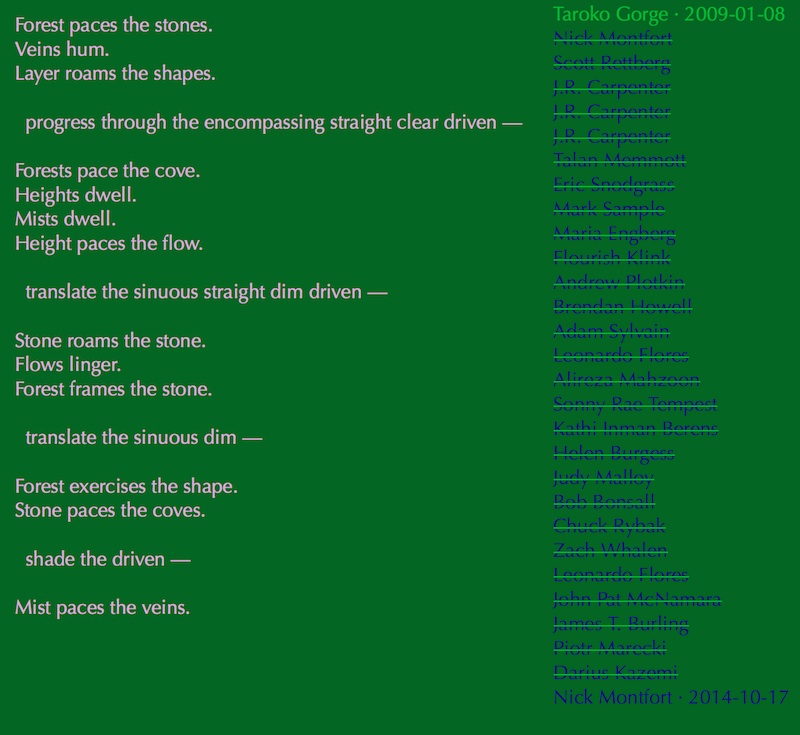
When Nick posted Taroko Gorge online in 2009 I decided to try my hand at hacking the engine, to see if I could invert and subvert it in a number of ways: to turn a poetry generator about nature into a generator about the cosmopolis, to take a minimalist work and turn it into to a maximalist work, to turn a light, almost zen work, into a noirish and somewhat anarchic work. Working mainly with the vocabulary of the arrays, I changed all of the language while leaving the majority of the original code in place. I wrote a new poetry generator on Montfort's platform. I originally did this mostly as a kind of in-joke or constrained writing game, which I thought would amuse my friend and collaborator. I did this without Montfort's explicit approval. To ask permission would eliminate the surprise, the joke, and the nature of the work as a hack. I crossed out Nick's name and put my own name beneath it on the author line, providing acknowledgment via strikethrough, and then posted the new generator online.
There is a political economy at work here: begin with the very fact of the poetry generator's existence on the open network. A poetry generator serves no market function whatsoever. As a rule, it harvests nothing from its reader. In fact, it offers itself to you as a gift. I could appreciate Nick's poem, open its javascript source code, devour it, digest it, and in what Chris Funkhouser has called an act of anthropophagy, use it as the source for something new derived from it that nevertheless includes many of its essential elements. While this act was unsanctioned, Montfort's response was not to loathe this act of cannibalistic plagiarism, but to celebrate it, to repost the new creation and to encourage others to join in and behave similarly. Soon thereafter came J.R. Carpenter's Gorge, a poetry generator about the eating body, Talan Memmott's Toy Garbage, about cheap toys and kitsch culture, Eric Snodgrass's Yoko Engorged, a smutty treatment of John Lennon and Yoko Ono in bed, Mark Sample's Takei, George, about the Star Trek actor, gay rights activist, and internet personality. Dozens of other variations have followed .
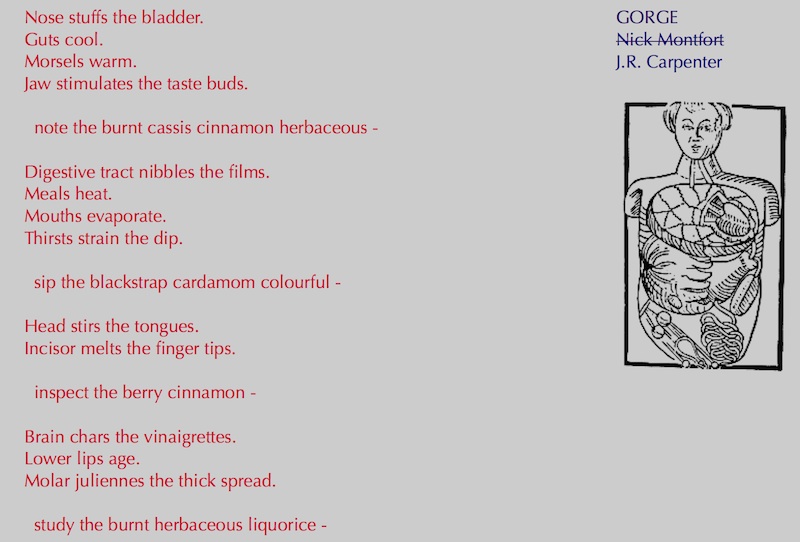
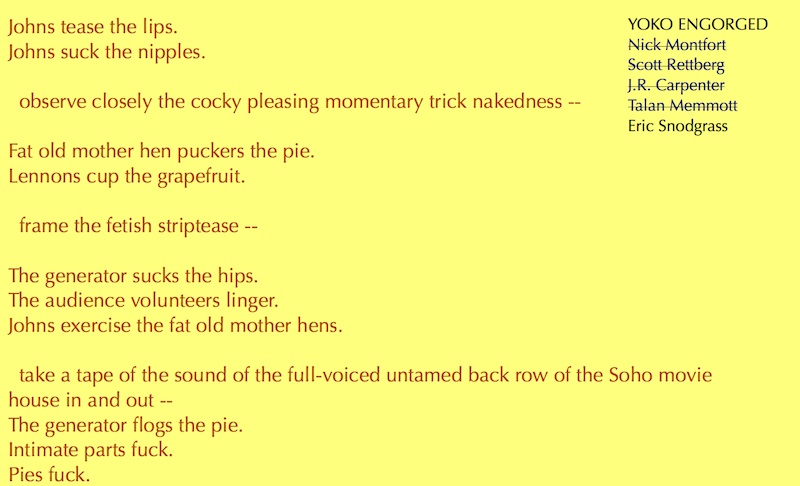
What began with Montfort's gesture of sharing a poetry generator on the open web, followed by my gesture of hacking, reposting, and sharing again, has become a kind of internet phenomena of sharing and creative cannibalism. It has also, not inconsequentially, served as a kind of gateway drug for writers new to electronic literature. Taroko Gorge supplies a route around the barriers to entry to digital writing for poets who might be interested in digital forms but are intimidated by programming. Whenever I'm talking with another writer interested in e-lit but who says "I'd love to try something like that but I don't know how to code," I open up the source of Taroko Gorge and say "Ah, perhaps you can't code yet, but surely you can replace some words with other words and see what happens?" Digging a new Gorge is that simple, yet it opens up strange and compelling complexities. Indeed Taroko Gorge is now often used as a teaching tool in electronic literature classes. Students in Kathi Inman Berens's Electronic Literature course at the University of Bergen, for example, produced twenty new Gorge-based generators during the Autumn 2014 semester alone, each radically different from the other, and in the process they learned some essential lessons about digital writing, computation, web design, and the alternative social network that electronic literature comprises.
In his writings on technologies of memory, Bernard Stiegler distinguishes between technologies that exteriorize memory in differing ways. Anamnetic technologies of memory, such as writing, require both the sender and the receiver be able to both code and decode them. Anyone who can read can also write. Stiegler distinguishes between these anamnetic technologies and industrial hypomnemata — such as Hollywood films for example — which separate producer from consumer. There is then a loss of individuation in industrial hypomnemata. The viewer becomes part of a mass audience unable to respond in the same form. I can consume a Hollywood film but I cannot easily produce one in response. Stiegler finds the potential for anamnesis in digital technologies as he writes, "Cooperative digital technologies can be placed in the service of individuation, but only if the industrial politics of hypomnesis are implemented in the service of a new age of anamnesis." (Stiegler 84) The Taroko Gorge / Tokyo Garage phenomena is an example of true digital anamnesis. While I can write and respond to friends on Facebook, I cannot harvest and cannibalize from Facebook in the same way that is harvesting and cannibalizing from me. But I can cannibalize Taroko Gorge, and you can cannibalize Tokyo Garage, and we can all go on sharing and cannibalizing and building on and recycling each other's work until the cows come home, in a reciprocal, anamnetic relation. This farm is our farm.
II. Implementation: Writing on the World
I will next discuss an earlier work, also produced in collaboration with Nick Montfort, the sticker novel Implementation.
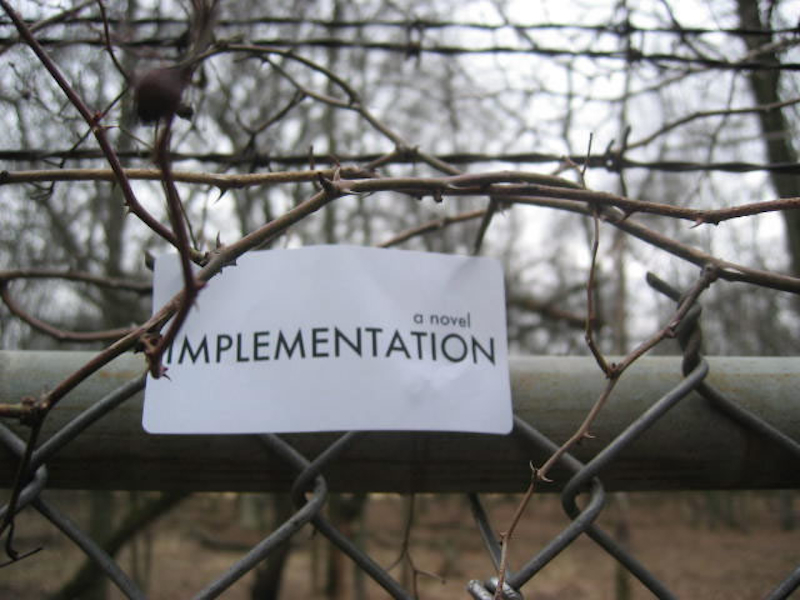
Implementation is a novel about psychological warfare, American imperialism, sex, terror, identity, and the idea of place, a project that borrows from the traditions of net.art, mail art, sticker art, conceptual art, Situationism, serial fiction, and guerrilla viral marketing. Implementation was first published in 2004-2005 as a serial novel made of 240 stickers, which were distributed in 8 installments of 30 stickers each. Readers then posted the stickers in public spaces around the world, photographed them, and returned those photographs to the project site, where they are archived by date and by location. In 2009-2010, the project was "re-implemented" — sent out to new participants, who installed the fragments of the novel in more locations, in order to gather new photos for a book project, which was published in 2012. The project has also been situated in the Web 2.0 context, as we have uploaded the photo archive to Flickr, and categorized and semantically tagged the images in the archive.
Implementation is about four people who live in the Midwestern American town of "Implementation." The action of the novel begins in September 2001 and runs through the beginning of Operation Iraqi Freedom in 2003. One of the characters, Kilroy, is a reservist who is called up and then sent to Iraq, but the others — Frank, CEO of a cardboard box manufacturer; Samantha, Kinko's employee; and Roxanne, who develops desktop publishing software — are affected in much more oblique ways by the attack on the World Trade Center and the United States' global war on terrorism. They continue to dine at restaurants, drink at bars, work, worry about their jobs and careers, notice what new stores are opening up, have flings and relationships, and go to celebrations and funerals. Even a bombing in town changes little on the surface of their lives. At the same time, the war's inception and progress can be read in the shifts in their gestures, longings, and language, as the peripheral, everyday psychological tolls of the "war on terror" become evident. Implementation is a historical novel about a time in America that seems too recent to analyze, but whose important subtleties have already been largely repressed or forgotten.
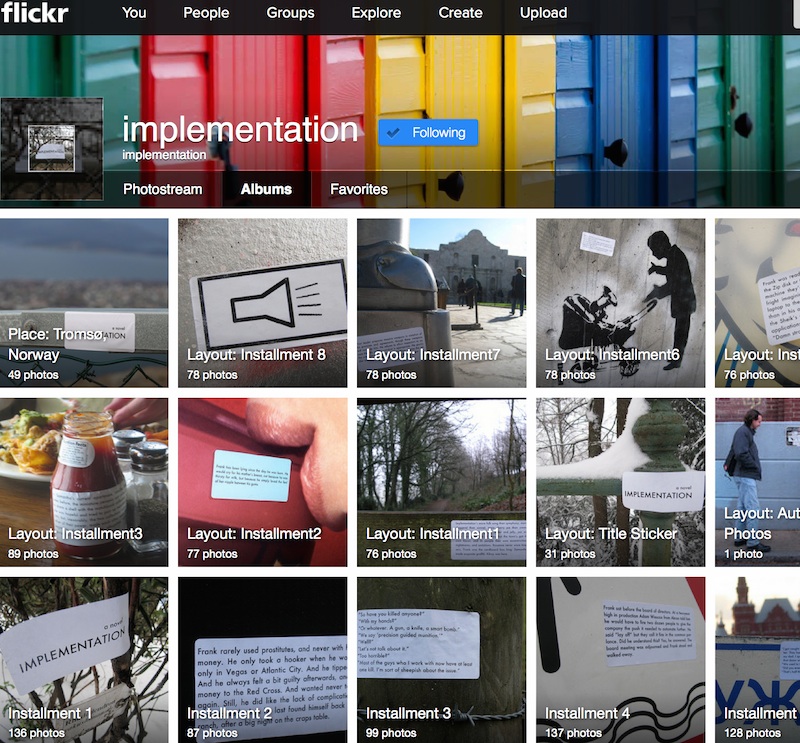
A few elements that I think particularly important to emphasize about Implementation:
1. The text attempted to respond to particular changes in the lived environment of the time it was written that Nick and I perceived as oppressive: the atmosphere of continual fear and the rise of a ubiquitous-surveillance "security state" after 9/11, accompanied by a politics of perpetual war. So the form of the novel, in stickers that would adhere to public surfaces of the world, was in response to the intrusive nature of many other texts, and laws and practices of paranoia and surveillance, which became prevalent after 9/11.
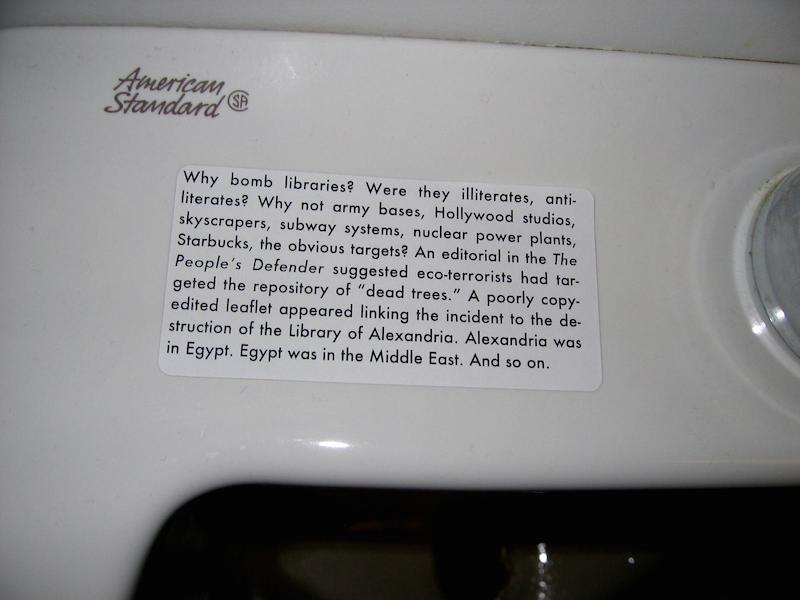
2. We can identify a number of different categories of readers of Implementation, each of whom experienced the project in a phenomenologically different way, even as a different artifact, based on the context in which they encounter it. The groups of "readers" of the project include the initial subscribers, who read the novel in its entirety in 8 separate installments received over the course of a year, 30 texts at a time, participant readers who chose to place the stickers in the physical world and photograph them, online readers who either read the PDF files online, or browse through the archives of photographs, readers who encounter the project at random in the physical world, art gallery readers, who have encountered images of Implementation in museum or gallery contexts, and finally book readers, who encounter documentation of the novel in its entirety as a photo book. The "participant" readers of Implementation were, importantly, asked to do something marginally subversive, and in some contexts illegal. Business-sized shipping label stickers filled with narrative text are hardly most conspicuous form of graffiti, and they are easy to remove, but putting up, photographing, and leaving a text adhered to a public environment is performative in a different way than simply reading a story. These participants were also interpreting the text and translating it into a new form, a photograph of a text in space, and so became co-creators of the work in a very material way.
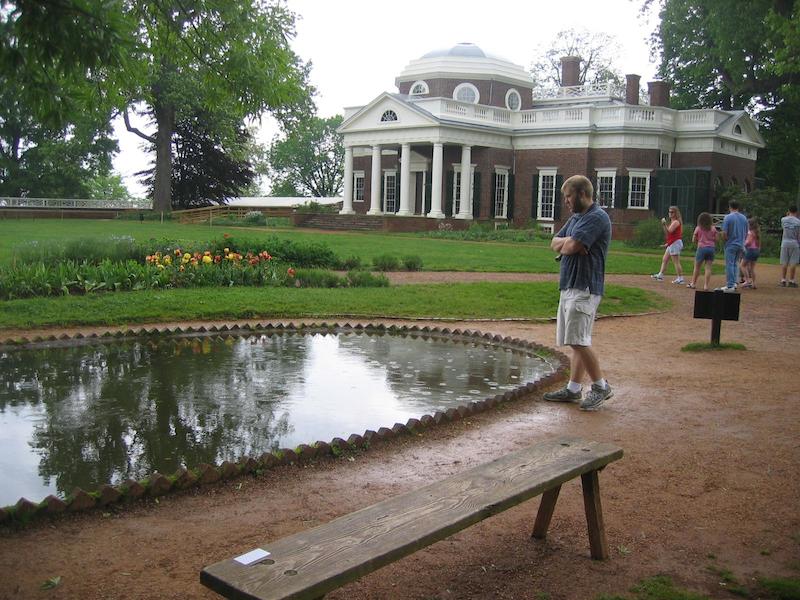
3. As implied above, Implementation is an iterative work that took multiple forms — it has appeared as PDFs of sticker sheets, as individual stickers situated in the world, in online databases of photographic documentation, in gallery installations, in performative readings, and as a photo book. In every case, although elements of the text are consistent, the project changes as it manifests in these different contexts. I think this is something it has in common with many examples of contemporary electronic literature, which are perhaps best thought of not as individual "works" per se, but as projects that have multiple manifestations in different cultural contexts.
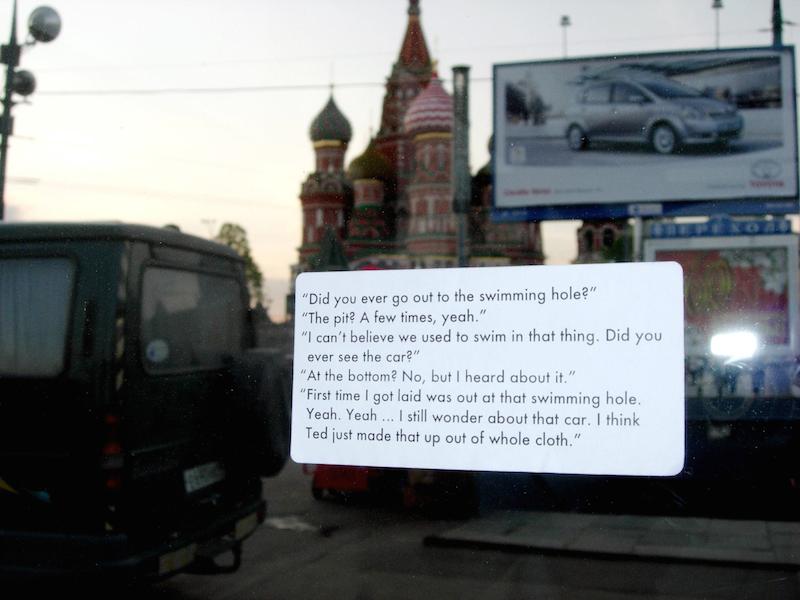
III. Katastrofetrilogien / The Catastrophe Trilogy: Disaster and Memory
Since 2010, I have collaborated with filmmaker Roderick Coover on narrative films, combinatory films, and an immersive virtual reality project. The majority of these projects in some way address problems faced by contemporary society, most predominantly the increasing toll that climate change is taking on the world that we inhabit and have transformed in the anthropocene era. In particular, we are interested in exploring how the human situation is itself changing in an environment that has been modified by human action to an extent of inevitability. That is to say that whether or not we agree that the industrialization and inexorable growth are at the root of many of the problems we face as a species, we must recognize that the problems are present and to a great extent beyond our control. Philosopher Timothy Morton describes "hyperobjects." These are objects, systems, or phenomena that are so distributed in time and space that can be said to confound any sense of spatiotemporal fixity or real human comprehension: for example global warming, styrofoam, or plutonium. In Morton's view, it is no longer sensible to worry about the end of the world, because the end of the world-as-such — as a construct of human-centered and human-controlled life context — has already occurred. Rather it makes sense to think now in the context of the human reaction to and human situation within a geophysical reality in which we have only limited agency. Our projects are largely concerned with this present moment of life in the midst of a continually unfolding catastrophe.
The first three films that Coover and I made between 2010 and 2012 are particularly concerned with the reception of catastrophes and disasters, how we as a species and in particular as a hypermediated species pay attention to, absorb, and then fail to remember or mark patterns of catastrophe, or to change our behaviors or economies as a result of them. So the three films center on historical disasters that have managed to be forgotten and yet mirror contemporary concerns. These individual catastrophes can be understood, in Morton's terms, as moments of surfacing, in which hyperobjects become visible to us, before we again dismiss them as too terrible to contemplate, and remove them from our view.
While I have collaborated with other writers and artists throughout my career, the collaboration with Coover has opened up new avenues of research and creation for me, as he and I come from such different creative backgrounds, as filmmaker and fiction writer. While we work together very closely on many aspects of our projects, we also maintain a clear separation of roles: I supply the words (and sometimes programming) and Rod supplies the images. We converse and we critique each other's work in between, but we each return to our zones of production. This separation has been useful as we conceive of creative process as a dialectic between language and image that has a great deal in common with surrealist methods of collaboration and with a database logic. Even in the films that have a fixed structure, we don't necessarily start with a fixed script and then shoot from it, but often begin with a set of images and/or a set of texts. We exchange texts and images in an iterative process, developing both the images and the eventual script in tandem, with elements building in response to each other and layering. Then we work with voice actors. In most of the films we have made so far, humans are a strong presence, but generally as voices rather than as embodied actors seen on screen. This is partly to do with the practical considerations of making films on a low or no budget, but it is also a consequential aesthetic choice. The images in the films, of panoramic landscapes, of shipyards and abandoned buildings and industrial sites, of shorelines and ominous waters, are coupled with voices in ways I think bring us closer to the consciousness of individual speakers even as we are distanced from their bodies. These rich images of depleted environments, and the chilling absence of human activity to be found in them, also echo the anxieties which are at the heart of the trilogy of films.
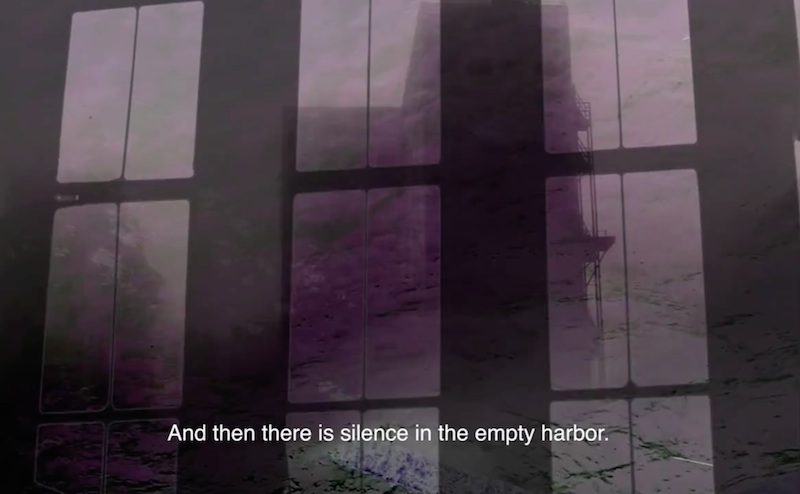
It is somewhat obvious but nevertheless worth noting that the voice actors interpret the texts that we provide them, and those interpretations have radically transformative effects on the resulting narrative, as their voices embody the text. The human voice is an incredibly powerful instrument, and the same words can mean radically different things depending on how they are vocalized. I am always surprised by the way that the movement from the page through the minds and vocal cords of the actors translates my writing into something other than what it was on the page. The iterative process of combinatorial exchange continues through this stage of the process. We have sometimes recorded multiple takes of these scripts with different actors, or changed the script after the recordings have been produced. The speech act becomes part of the writing process.
The films of The Catastrophe Trilogy are about memory, cultural memory. A secondary concern of this series of films is interlinguistic communication and miscommunication across cultures. All of the films are in some way bilingual, including Norwegian and English. The three films in the trilogy each take a historical disaster from the history of Norway and re-situate it, using the historical event as a lens through which to view and consider contemporary circumstances: The Last Volcano / Det siste utbruddet focuses on an 18th-century volcanic eruption in Iceland, which subsequently had serious impacts in Norway and Europe; Cats and Rats / Rotter og katter centers on memories of the black death, filtered through a blind date between an American epidemiologist and a Norwegian woman conducted on Skype; Norwegian Tsunami / Norsk flodbølge deals with a devastating prehistoric tidal wave which carved away parts of the Norwegian and Scottish coastline and in the process created the English channel. That film is set within a conversation between a Norwegian chef and a Scottish engineer that takes place on an oil platform in the North Sea.
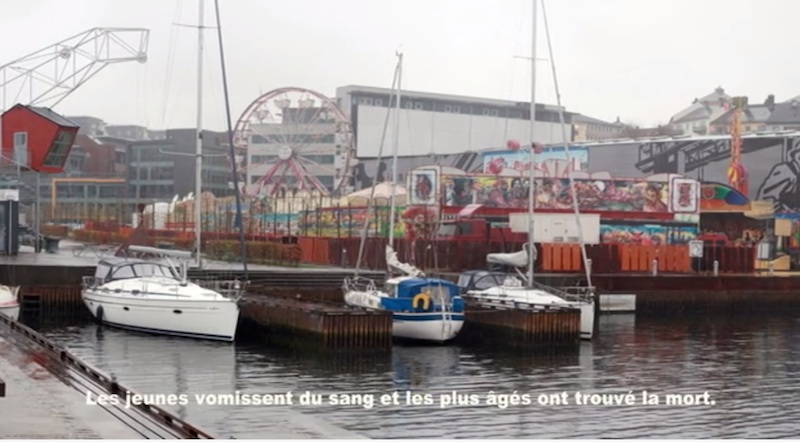
IV. Three Rails Live: Dissolution and Juxtaposition
Three Rails Live (2012) (see excerpt online) is a cinematic project that is explicitly combinatory in structure. Roderick Coover, Nick Montfort and I developed this project together, working between Bergen, Philadelphia, and Boston, and finished the first draft while travelling on a train from Philadelphia to Providence for events at Kelly Writer's House and Brown University. In this case, the creative process was very much like constructing an exquisite corpse. Rod first emailed Nick and I some images. Working independently, Nick and I each had different reactions to them. As I perused the images, I began to code them into themes, and to think of them as writing prompts that might become building blocks of a narrative. Nick, taking another approach, responded to them in an aphoristic way, and wrote responses to them in a form that Harry Mathews coined perverbs — yoking together two proverbs and creating a new, often comical, meanings from them. As in other projects, the process included several cycles of exchange, with Rod adding new images and video to the database in response to the texts we were giving him, and we in turn writing new texts in response to those images.
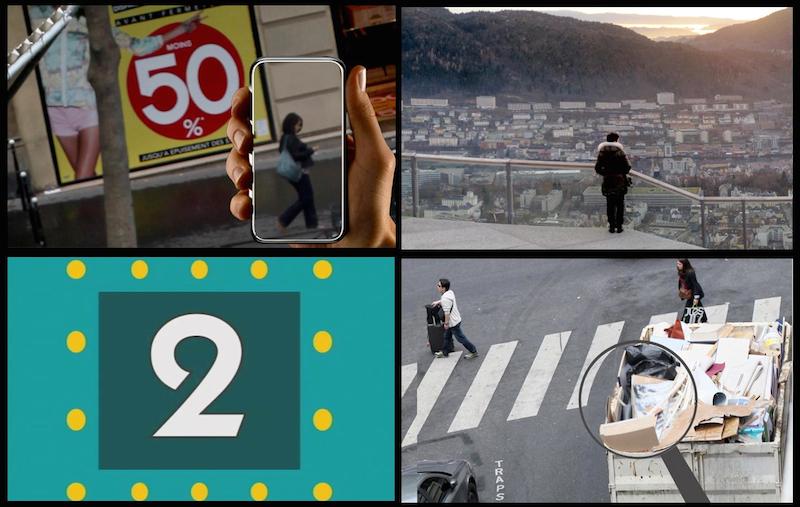
In reaction to a series of images of the desert and of a young man handling a snake, I for example wrote the following series of short monologues:
DEATH BY SNAKE
He died about fifteen minutes after he was bitten by the snake. She cried out the very moment he was bitten, as if she knew what would come. That it would be the end of things. Or an end of something. For a moment it was like a scene in the garden, the Garden of Eden. But as she watched him dying on the sand, in that unbearable heat, it was actually just another scene in her desert of the real.
She always knew that he would die in some idiotic way. She expected that it would be some sort of car crash or skiing accident or some type of household incident involving a blender or an electrical fire of some kind maybe a heart attack at a steakhouse after he ordered something medium rare but she never expected he would die of a snake bite. Sort of a dramatic death: Replete with metaphoric associations. She did not think that he would die like that. He didn't know what to think. Is there some kind of anti-venom?
At some point fate will reach out for you. Or coincidence will. Something from an actuarial table. I suppose it's not really fate — it's just circumstance. Fate is just a sort of comforting umbrella for the unexpected. Some sort of unanticipated death will be there for you. Or some sort of anticipated death. I suppose we all anticipate death at some point though we live as if we are immortal. Few of us will actually die at the hands or rather teeth of a small animal. Do you say "died at the teeth of" if you die from a bite, from a small animal, from poison? How would you go about describing that? As he was dying, all of it struck him as absurd — not just the snakebite — the whole ball of wax. He found himself thinking of the phrase "winterize your tires" and he thought "that's funny."

Montfort responded to the same image with the perverb: "A narrow fellow in the bush ... is worth two in the hand."
When we looked at the texts and images we had independently produced and considered how they might fit together, we concluded that Nick's perverbs might serve as "morals" to the story. Nick also produced a title generator that yokes together two words from an array, e.g. "BETWEEN STATIONS", "BETWEEN GLANCES", "TRADING GLANCES", "EMPTY STATIONS" creating a new title on each run. So on each cycle, the program generates a story title, selects two spoken narratives from the database and matches them two video segments (one with matted imagery, and one not matted), and provides one moral to the story. The narratives are joined to the video in a process that is also aleatory. The juxtapositions between the image and the text, and the morals to the stories, are thus different every time the program runs. Though the juxtapositions are randomized, the texts were all written in response to images in the set, so there is a kind of thematic cohesion even though the procedures involve randomization .
Another fairly odd circumstance played into my writing process: During this period I had nearly lost a finger after a colleague had accidentally guillotined my hand in a car door, and my right hand was healing in bandages. So I wrote the narrative texts using a speech-to-text dictation program. This is the first time I tried writing by first speaking. I then (with my remaining good hand) edited the texts that I had spoken, and recorded them as voice-over tracks. So the narratives started as vocalizations, and then became texts, and then became vocalizations again. The story that emerged from my response to the images in the fragmented narrative is one of dissolution, both of a particular human life and of the global environment.
View Project: VIEW video documentation of Three Rails Live
V. Toxi•City: After the Deluge
Toxi•City is a hybrid-narrative film that follows six fictional characters who live in a near-future landscape along the eastern seaboard of the USA, in the area of the Delaware River Estuary, which was one of the first industrialized port districts in North America and is today home to five of its largest oil refineries. The project asks what how conditions of life would change if repeated storm surges and tides flooded the densely populated lands with toxins from the hundreds of sea-level petrochemical industry sites and post-industrial brownfields.

Toxi•City was originally made for a commission for the Sensing Change exhibition at the Chemical Heritage Foundation Museum of Philadelphia in 2013, which presented artworks communicating scientific knowledge about climate change. In October 2012, just as we had begun work on developing script ideas for the commission, Hurricane Sandy hit the east coast of the USA. I remember that I was attending the ELMCIP conference in Edinburgh, Scotland opened my hotel room door and saw the front page of the newspaper, printed a few days after the storm. President Obama was standing on the shore in front of a scene of devastation. The scene looked strangely familiar to me, and then I realized that Obama was standing on the Atlantic shore of Brigantine, the boundary island where I used to live in New Jersey. The house where I used to live was somewhere in that flooded landscape of ruined homes. Since the reality of Sandy related so directly to the potential near-future we intended to visualize in the film, we decided that the film should integrate a non-fiction layer that referenced this real storm and its direct consequences. The fictions of Toxi•City are thus interspersed with nonfictional accounts of deaths that occurred during recent storms in the area, including some of many who died in New Jersey and New York as a result of Hurricane Sandy.
Like Three Rails Live, Toxi•City is a combinatory film. As we watch the film, some stories seem to resolve, while others unravel. Just as with the conditions of ocean tides and tidal shores, the stories cycle and change without clear beginning or end. Individuals grasp for meaning from fleeting conditions of a world in flux. As the characters paths intersect, story threads come together. These offer moments of resolution, contact and visions of the future, before the narratives are broken apart and a fresh cycle begins anew. It is a hybrid film in that it combines narrative elements with documentary imagery and elegiac nonfictional anecdotes, tying imagined futures to the realities of our contemporary condition. The inclusion of these short fragments of real lives lost in contemporary storms grounds the speculative elements of the climate change narrative. The fact that there are many of these stories of personal demise, and that viewers of the film never encounter the same combination of these fragments twice, reiterates the immense scale of loss that such disasters involve.

During 2014, we have expanded the project to a feature-length version. We are still in the process of adding new clips to the database that expand the context of the narrative. Toxi•City is adapted differently for different screening situations. When it is run in a museum context as an installation, it will run for about 30 minutes before regenerating a new version. In cinematic settings, it can be shown as a feature length film of about 50 minutes. When the project is complete, there will be about 120 minutes of content in the database, so any given run will include only about half of the potential narrative. We have produced a number of different versions of the project for different installation and screening contexts, recoding the work for these varied contexts: for example a "feature screening" version which we showed at an Ecopoetics festival in Brussels in 2014, which pulled from the database in a rhythmic structure without repeating for just under an hour, has a quite different narrative structure from the Spring 2015 installation version we showed as part of the "Placing the Golden Spike: Landscapes of the Anthropocene" exhibition at Inova Gallery in Milwaukee. In that most recent version, the work is coded to emphasize on particular character over the course of a short cycle before emphasizing another character on the subsequent run. We anticipate different viewing contexts in a cinema environment than in an art gallery. Because of the project's database logic, the narrative structure is highly malleable and can change radically from one iteration to the next.
View Project: VIEW a 5-minute sample documentary video of Toxi•City
VI. Hearts and Minds: The Interrogations Project: Addressing a Travesty in a CAVE
The last project I will briefly discuss here is Hearts and Minds: The Interrogations Project. This project makes use of the CAVE2™ environment for a multisensory artwork that addresses a complex contemporary problem: as American soldiers are returning from wars in Iraq and Afghanistan, it is becoming increasingly clear that some of them participated in interrogation practices and acts of abusive violence with detainees for which they were not properly trained or psychologically prepared, and in some cases committed war crimes. This has left many soldiers dealing with Post-Traumatic Stress Disorder on their return home, and left many unresolved questions about the moral calculus of using torture as an interrogation strategy in American military operations.
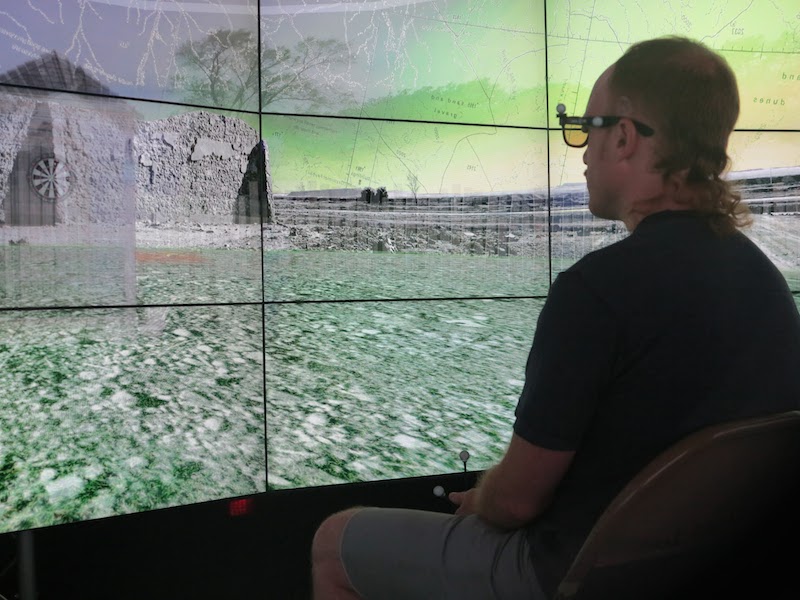
This project is based on scientific research that addresses a significant problem — the cultural inheritance bequeathed us by the tactics employed during the war in Iraq. Based on interviews of soldiers who participated in or observed acts of torture rather than purely statistical data, this problem was then further narrativized through visualization techniques. The immersive 3D environment of the CAVE is here intended to provide an affective environment that produces a space for interpretation. The visualization environment serves as a dispositif for enacting individual and cultural memory of an institutionalized atrocity.
The project was developed through a unique collaboration between artists, scientists, and researchers from four universities. The project is based on interviews of American soldiers conducted by political scientist, Dr. John Tsukayama. I was the lead writer on the project, adapting a script from material gathered in 17 interviews that Tsukayama conducted with American soldiers who had been directly involved with interrogations of prisoners in Iraq, many of which crossed the line into the zone of torture. The development team included filmmaker Dr. Roderick Coover, artist and visualization researcher Daria Tsoupikova, computer scientist Arthur Nishimoto, and sound designer Mark Partridge. Dr. Jeffrey Murer, Lecturer on collective violence at St. Andrews University, Scotland also contributed as a consultant on the project.
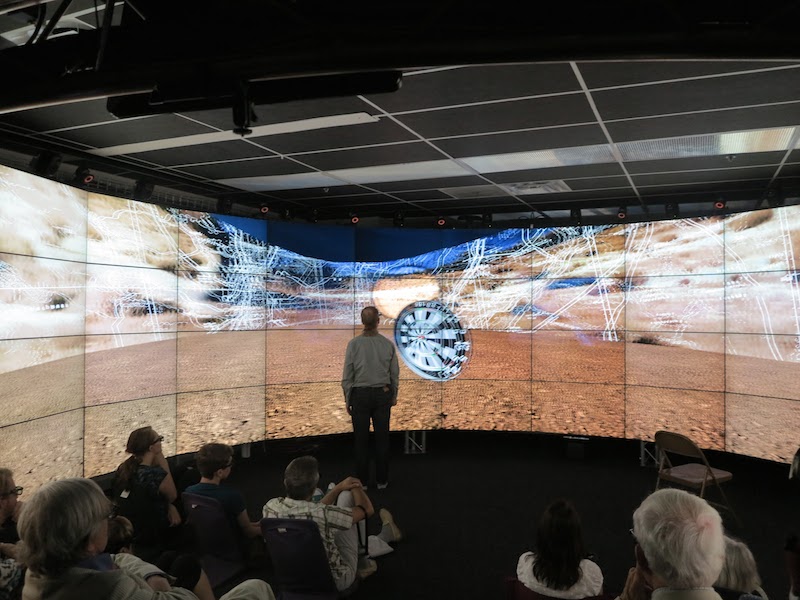
The project presents the audience with a narrative environment that begins in a reflective temple space with four doors opening to ordinary American domestic spaces: a boy's bedroom, a family room, a suburban back yard, a kitchen. The performer navigates the environment using a wand, a 3D mouse, to interact with and control a VR experience in the CAVE2™. The virtual scene is continuously updated according to the orientation and position of the head, as measured with head and arm trackers, and the 3D view of the scenes is focalized on this perspective. Moving through and exploring each these rooms inside the virtual scene creates a sense of being immersed in the virtual environment. Using a wand with buttons, the navigator triggers individual objects, such as a toy truck, a Boy Scout poster, or a pair of wire cutters. When each object is activated, the walls of the domestic space fall away and a surreal desert landscape is revealed in 2D surrounding panorama, and one of the four voice-over actors is heard recounting particular acts and memory related metaphorically to the object selected. The objects also function very much like hyperlinks in moving us from one narrative element to another. Viewers travel through the domestic spaces and surreal interior landscapes of soldiers who have come home transformed by these experiences, triggering their testimonies by interacting with objects laden with loss.
Hearts and Minds was first presented in performances in June and July 2014 at the Electronic Visualization Lab on the campus of University of Illinois at Chicago. Like many artworks for advanced visualization environments, its context limits the size of the audience that can have access to it. You cannot simply throw a CAVE into your backpack to show at the next conference you happen to attend. Because we were very aware of this limitation and want the work to reach audiences beyond that original context, and because of the fact that the work is developed in Unity, we are able to port it so that it can be accessed in other platforms. We have currently developed an application version for cinematic performance. A web-player version and a version for iPad and Android tablets are also in the works. While these versions do not have the same effect of total immersion that the CAVE provides, they will make the project accessible to a wider audience. A brief online documentation video and script are available below for an impression of the work in its original context.
View Project: VIEW video documentation of Hearts and Minds
View Project: READ the script for Hearts and Minds
VII. Conclusion: The Ends of Electronic Literature
I think it is important to resist the notion that the primary value in the field of electronic literature is or should be the novelty of digital forms; there are problems with the innovative aesthetic use of the device for the sake of innovation alone. If the modernists implored us to "Make it new" I sometimes feel that in electronic literature we see the invention of new genres at the speed of technological innovation: too many new forms, too fast, in a kind of Futurist blur of acceleration. There is a real tension between continuous innovation and meaningful literary expression. If every artist produces a new form, if every work manifests a new genre, electronic literature might never develop the richness of shared contexts and discursive context, the dialectics of tradition, transition, and originality that characterize print literary traditions. So I might stand among the garde-derrière rather than the avant-garde of this field, and argue that one of the imperatives of the field of electronic literature should be to "Make it not new." Play and innovate, by all means, but try to work with forms and genres until they become available at-hand as creative environments and pliable as forms of expression, potentially as a means for reflecting and commenting critically on contemporary social and political reality. That is to say "Make it about now" without worrying about whether or not the form is particularly new. Explore by all means, but also map and inhabit one territory before rushing on to the next. Use new forms not merely to celebrate their technical affordances, but because they enable the work to mean something in the present in a way that it otherwise could not.
I would never argue that technical innovation is unimportant in experimental narrative in digital media, nor that literature should in every case address the societal challenges and controversies of contemporary life. But this kind of work offers us the potential to do much more than play language games in digital media. Multimedia, computational, networked environments offer us powerful new ways to communicate and to wrestle with the challenges we face as human beings in the 21st century. One of the most important functions of print novels has been to provide us with a way to process and frame our culture as we have lived within it, as we collectively construct our future memories of the past. Works of digital narrative offer the same potential in the networked computational reality of the present. It is an ethical imperative for artists work in digital media to engage with and confront that reality. Electronic literature's specificity as an art form produced within the dominant communication environment of our age, within the very same apparatus that seeks increasingly to monitor and discipline, to afford and constrain, our shared reality nearly demands that we engage critically with that apparatus and produce artworks within the digital context that are not simply reflexive about their own form as digital artifacts, but instead provide us with new ways of reflecting on our situation within and our relations to a troubled and challenged planet.
Acknowledgements
This essay and the projects it describes would not have been possible without the support of both people and institutions that have made the work possible. In addition to the collaborators I have named above, I have been grateful for the support of institutions in Europe and the USA In particular, I would like to acknowledge the support of the H2H Arts Labex at Paris 8 university and the students and faculty I worked with during my stay there in Nov-Dec. 2014. Both the Norwegian Research Council and Arts Council Norway have funded various aspects of my work on these projects. The University of Bergen has supported my unconventional path as a hybrid researcher/artist, and members of the Bergen Electronic Literature Group through engaged critical discussion and shared projects have helped to make Norway an exceptional research environment for electronic literature. The Electronic Visualization Lab at UIC was enormously generous in opening their facility and resources to the Hearts and Minds project. Brown University, Temple University, and MIT have also supported these collaborations in various ways ranging funded support to opportunities to show work-in-progress versions to an engaged audiences of digital arts researchers and artists, whose feedback has been essential to the development of the projects.
References
Carpenter, J.R. Gorge. 2011. Web. 12 Jun. 2015. «http://luckysoap.com/generations/gorge.html».
Coover, Roderick, David Jhave Johnston, & Scott Rettberg. "The Poetics of Combinatory Cinema: David Jhave Johnston interviews Roderick Coover and Scott Rettberg." SoundEffects - An Interdisciplinary Journal of Sound and Sound Experience [Online], 4.1 (2014): 108-129. Web. 5 Jun. 2015. «http://www.soundeffects.dk/article/view/20329/17916»
Coover, Roderick and Scott Rettberg. Cats and Rats / Rotter og katter. 2011. Web. 12 Jun. 2015. «https://vimeo.com/50355051».
Coover, Roderick and Scott Rettberg. Norwegian Tsunami / Norsk flodbølge. 2012.
Coover, Roderick and Scott Rettberg. The Last Volcano / Det siste utbruddet. 2010. Web. 12 Jun. 2015. «https://vimeo.com/57377350» (English subtitles). Le Dernier Volcan (French subtitles) «https://vimeo.com/113107102».
Coover, Roderick, Nick Montfort, and Scott Rettberg. Three Rails Live. 2012. Web. 12 Jun. 2015. Sample online: «https://vimeo.com/73507741».
Coover, Roderick, Arthur Nishimoto, Scott Rettberg and Daria Tsoupikova. Hearts and Minds: The Interrogations Project. 2014. Application for performance in the CAVE2™ immersive virtual reality environment in the EVL at University of Illinois Chicago, and as a standalone Unity application for other platforms. Short documentation video excerpt: «https://vimeo.com/107178964».
Coover, Roderick, Arthur Nishimoto, Scott Rettberg and Daria Tsoupikova. "Hearts and Minds: The Interrogations Project." Short paper. IEEE 2014 VIS Arts Proceedings. Web. 12 Jun. 2015. «http://visap.uic.edu/2014/papers/16_Coover_Hearts_VISAP2014.pdf».
Funkhouser, Chris. "Cannibalistic Tendencies in Digital Poetry: Recent Observations and Personal Practice." 2009. Harriet (Poetry Foundation blog). Web. 12 Jun. 2015. «http://www.poetryfoundation.org/harriet/wp-content/uploads/2009/12/bergen2nx1.doc».
Memmott, Talan. "Toy Garbage." 2010.
Memmott, Talan. Digital rhetoric and poetics: Signifying strategies in electronic literature. Diss. Malmö University, 2011. PDF online. 12 Jun. 2015. «https://dspace.mah.se/handle/2043/12547»
Montfort, Nick and Scott Rettberg. Implementation, a novel (project site). 2004. «http://nickm.com/montfort_rettberg/implementation/».
Montfort, Nick and Scott Rettberg. Implementation, a novel (Coffee table photo book, 270 pages). 2012. «http://www.blurb.com/b/3442475-implementation».
Montfort, Nick and Scott Rettberg. Implementation (Flickr photo archive). 2010. «https://www.flickr.com/photos/implementation».
Montfort, Nick. Taroko Gorge. 2009. «http://nickm.com/poems/taroko_gorge.html».
Morton, Timothy. Philosophy and Ecology After the End of the World. Minneapolis: University of Minnesota Press, 2013.
Rettberg, Scott. "Dada Redux: Elements of Dadaist Practice in Contemporary Electronic Literature." The Fibreculture Journal [Online], 11 (2008). Web. 5 Jun. 2015. «http://eleven.fibreculturejournal.org/fcj-071-dada-redux-elements-of-dadaist-practice-in-contemporary-electronic-literature/»
Rettberg, Scott. "Tokyo Garage." 2009. Web. 5 Jun. 2015. «http://retts.net/tokyogarage.html».
Rettberg, Scott. "Human Computation in Electronic Literature" in Handbook of Human Computation. Pietro Michelucci, ed. New York: Springer, 2013. Available online: «http://elmcip.net/node/8844».
Sample, Mark. "Takei, George." 2011. Web. 5 Jun. 2015. «http://samplereality.com/elit/takeigeorge.html».
Snodgrass, Eric. "Yoko Engorged." 2011. Web. 5 Jun. 2015. «https://5b7705e49483ebcda62f8e746f72b423a3b47a11.googledrive.com/host/0B-_xkDymIRrCODBxaFFobnRaUlE/index.html».
Stiegler, Bernard. "Memory" in Critical Terms for Media Studies. W. J. T. Mitchell, Mark B. N. Hansen, eds. Chicago: University of Chicago Press, 2010.
Notes
- This essay was first presented as the 13th Hybrid Conference of the H2H Arts Labex on December 8, 2014 at Paris 8 University during my two-month stay there as an international chair.
- Walsh, Brian. "The Surprisingly Large Energy Footprint of the Digital Economy." Time Magazine 13 Aug. 2013. Online.
- See Rettberg "Human Computation in Electronic Literature" for a detailed discussion of human computation and how it is manifested and critiqued in some works of electronic literature.
- Nick Montfort is someone who I would describe as this sort of activist. His "Facepalm at the End of the Mind" is a high-quality rant against Facebook and an elegy for the Web that very nearly made me stop using the social network. Though it didn't quite work. I'm still on Facebook.
- The Taroko Gorge remix phenomena has been addressed by a number of electronic literature scholars. See the ELMCIP Knowledge Base record for Taroko Gorge: http://elmcip.net/creative-work/taroko-gorge for critical references. Talan Memmott's dissertation Digital Rhetoric and Poetics: Signifying Strategies in Electronic Literature includes a chapter "The Little Engine That Could: Poetry Generators and the Case of Nick Montfort's Taroko Gorge" which deals with the project quite extensively: http://elmcip.net/sites/default/files/files/attachments/criticalwriting/memmott_digitalrhetoricandpoetics.pdf
- It is also the case that the human brain has a tendency towards closure between image and text. If we present a text (or a voice) with an image, an audience will tend to form a coherent association between them, even if there is no authorial intention behind it. An interesting early net art example of this was "You and We: A Collective Experiment" — an artwork driven by collective participation. Users would login, and post images or short text content. The system then randomly presented juxtapositions of image and text from this user-created database in time to a driving music soundtrack. Whenever I showed this work to electronic literature students in courses I taught, introducing it as "a digital poem" students would inevitably to read it in the same way as any linear, intended work of digital poetry, and have few problems with doing so.